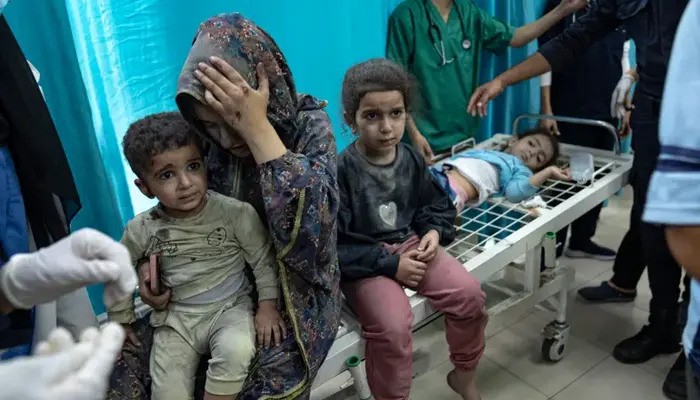X users share Gaza crisis with harrowing accounts and satellite evidence showing the devastation of Gaza’s education system, the collapse of hospitals, and the worsening famine. Posts from aid workers, journalists, faith leaders and activists highlight the human toll of the war, with calls for a ceasefire intensifying worldwide.
Schools in Gaza Almost Destroyed
The United Nations Relief and Works Agency (UNRWA) confirmed that Gaza’s education system is near total collapse, with almost every school building damaged. Recent UNOSAT satellite imagery shows that more than 97% of schools, including UNRWA facilities, require either complete reconstruction or extensive repairs.
Read more: 97% of Schools in Gaza Destroyed, UNRWA Confirms
According to UN data, between 12 and 20 August, intensified Israeli military operations in Gaza city forced over 16,000 people to be displaced.
These families had to carry tents with them as no new shelter supplies have been allowed into Gaza for almost 6 months. They are… pic.twitter.com/1fCthVHBUi
— UNRWA (@UNRWA) August 23, 2025
UNRWA said schools must be protected at all times, warning that the destruction of classrooms is destroying the future of Gaza’s children. It also published a Global Education Cluster report verifying damage based on proximity to bombed sites.
Read more: PDMA Issues Flood Warning in KP Amid Heavy Rains
Online Outcry Over Education Collapse
On X, users are voicing anger over the scale of destruction. Activists argue that the targeting of schools violates international law. A widely shared post read: “Israel destroyed Gaza materially, but Gaza destroyed Israel morally.” Others circulated new aerial images showing ruins of school buildings, describing them as proof of the devastation.
Another viral post recalled Cardinal Matteo Zuppi’s reading of the names of every child killed in Gaza. The solemn act reportedly took seven hours, underlining the catastrophic loss of life.
Famine Declared in Gaza
The humanitarian crisis extends beyond education. X users are also sharing updates about worsening hunger. Human rights advocate Mohamad Safa posted: “Famine has officially been declared in Gaza. It’s not famine. It’s forced starvation. And forced starvation is an act of genocide.”
#Gaza‘s education system is on the verge of complete collapse, with almost every school building damaged in the war.
Recent @UNOSAT satellite imagery shows that more than 9 out of 10 schools – including UNRWA’s – will either need full reconstruction or major work to be… pic.twitter.com/ntBUuYfPco
— UNRWA (@UNRWA) August 24, 2025
The Integrated Food Security Phase Classification (IPC) has confirmed that more than half a million people in Gaza face famine conditions. Aid workers say children are the most affected, with many dying from malnutrition while hospitals run out of space and supplies.
Hospitals at Breaking Point
Liz Allcock from Medical Aid for Palestinians described the dire situation inside Gaza’s hospitals. She said paediatric and neonatal intensive care units are overwhelmed with malnourished infants, leaving no room for patients injured in bombings and shelling.
“On one hand, you have massive overcrowding in emergency rooms where people are treated on the floor,” she explained. “On the other, you see malnourished children in a bed while three others lie nearby with injuries, and in many cases a dead body because morgues are full.”
Her remarks, shared widely on X, illustrate the desperate conditions under which Gaza’s health workers operate.
International Reactions Gaining Attention
International responses are also trending online. One widely circulated post by Mega-Politics claimed that Sweden called for the arrest of Israeli Prime Minister Benjamin Netanyahu over the killing of thousands in Gaza. Although the post has not been independently verified, it sparked intense debate on X.
Users from different parts of the world are also demanding accountability and an immediate ceasefire. Hashtags such as #CeasefireNow and #Gaza continue to dominate discussions.
New aerial image shows what the “most moral army in the world” did in Gaza! pic.twitter.com/Un6E0UN3I4
— Motasem A Dalloul (@AbujomaaGaza) August 24, 2025
Displacement Adds to the Crisis
UNRWA reported that intensified Israeli operations in Gaza City between 12 and 20 August displaced more than 16,000 people. With no new shelter supplies allowed into the enclave for nearly six months, families are carrying tents to overcrowded school-turned-shelters.
Israel destroyed Gaza materially,
but Gaza destroyed Israel morally. pic.twitter.com/v8gxp5TeJr
— Mohamad Safa (@mhdksafa) August 22, 2025
According to UN data, between 12 and 20 August, intensified Israeli military operations in Gaza city forced over 16,000 people to be displaced.
These families had to carry tents with them as no new shelter supplies have been allowed into Gaza for almost 6 months. They are… pic.twitter.com/1fCthVHBUi
— UNRWA (@UNRWA) August 23, 2025
“Nowhere is safe in Gaza,” UNRWA said in its latest statement, urging urgent action to halt military operations and allow humanitarian aid.
Voices from the Ground
Children continue to speak out through UNRWA’s campaigns. In one video, a girl named Leen said she lost her home, school and friends, but not her love for learning. “I will not lose knowledge,” she declared. Her words were widely shared on X, symbolizing resilience amid despair.
Cardinal Zuppi read the names of every child who died in Gaza. It took him 7 hours. pic.twitter.com/gN2afoIS8A
— cassie 🇻🇦 (@CatholicCassie) August 21, 2025
Famine has officially been declared in Gaza.
It’s not famine. It’s forced starvation.
And forced starvation is an act of genocide. pic.twitter.com/0HXZyYgHzU
— Mohamad Safa (@mhdksafa) August 22, 2025
Breaking:
Sweden says Netanyahu must be arrested for killing thousands of Palestinian people in Gaza. pic.twitter.com/vcx10i3HzU
— Mega-Politics (@_MegaPolitics) August 23, 2025
Follow us on Instagram, YouTube, Facebook,, X and TikTok for latest updates
